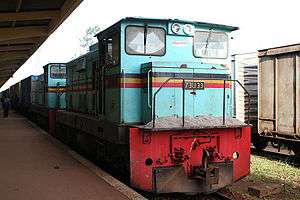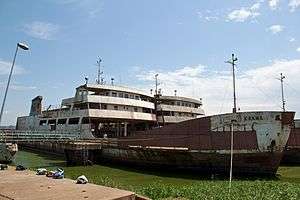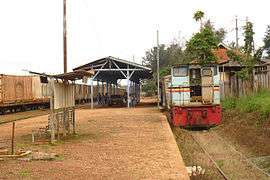Uganda Railways Corporation

Uganda Railways Corporation (URC) was the parastatal railway of Uganda. It was formed after the breakup of the East African Railways Corporation (EARC) in 1977 when it took over the Ugandan part of the East African railways.
URC’s system was rooted in the British colonial 1,000 mm (3 ft 3 3⁄8 in) gauge Uganda Railway that was transformed after World War I into the EARC. Its operation after the demise of the EARC had been hampered by civil war and inefficient management in Uganda. In 1989 government soldiers massacred sixty civilians at Mukura railway station.
Recently prospects for the URC have improved. Uganda Railways were joint recipients of the 2001 Worldaware Business Award for "assisting economic and social development through the provision of appropriate, sustainable and environmentally complementary transport infrastructure". The Uganda Railways Update Report gives details of management improvement.
South Africa Involvement

In 2005 Rift Valley Railways Consortium from South Africa was awarded a concession to manage URC and Kenya Railways[1] RVRC was scheduled to take over operations on 1 August 2006. On 28 July 2006 the East African Standard reported that the planned take-over was postponed to 1 November 2006.[2] This operational take-over took place in November and was scheduled to last for 25 years.[3]
Robert E. Mortensen, a 30-year veteran of Conrail who later led Railroad Development Corporation efforts in Mozambique and Malawi, served as Chief Executive Officer of Uganda Railways Corporation from 1 August 2006 until 30 October 2006, becoming the Chief Executive Officer of Rift Valley Railways Uganda Limited on 1 November 2006, when Rift Valley Railways Uganda Limited (as concessionaire) took over rail operations from Uganda Railways Corporation. Noel Muhangi of Kateera and Kagumire Advocates became Ag. Chief Executive Officer of Uganda Railways Corporation the same day.
2008 Kenya crisis
The 2007–08 Kenyan crisis included destructive riots that blocked and partly destroyed the rail system between Kenya and Uganda leading to economic difficulties in supply for Uganda. Further, destruction and loss of income led to significant financial losses.[4] Criticized for a drop in freight traffic, Rift Valley Railways Consortium pointed to the poor condition of the railway infrastructure and the damage done by protesters during the 2007–2008 Kenyan crisis.
On 9 October 2008, Toll Holdings of Australia announced that it had entered into a contract to manage the Kenya-Uganda railway, replacing management by Rift Valley Railways Consortium. Officers from Toll subsidiary Patrick Defence Logistics would manage the railway after the transition.[5]
Train ferries

URC operated three international train ferries on Lake Victoria: MV Kabalega, MV Kaawa and MV Pemba. However, in the early hours of 8 May 2005 Kabalega and Kaawa collided[6] almost head-on. Kaawa damaged her bow and Kabalega suffered damage to her bow and flooding in two of her buoyancy tanks.[7] Kaawa managed to return to port but a few hours after the collision Kabalega sank about 8 nautical miles (15 km) southeast of the Ssese Islands.[6] After the collision Pamba was suspended from service and no Ugandan ferries now remain in operation.
In May 2008 the Daily Monitor stated that it expected the Ugandan government to announce in that year's budget speech a government allocation of 14 billion Ugandan Shillings to buy a new train ferry to replace Kabalega.[8] However, in September 2009 Uganda Radio Network said the Ugandan government was unlikely to replace Kabalega soon.[9] Instead, the Minister of Works proposed to improve port facilities at Jinja and Port Bell and let private operators run railway car floats with greater capacity than the ferries.[9] The minister stated that Kaawa and Pemba would be reconditioned and returned to service and that private businesses had expressed an interest in raising Kabalega and restoring her to use as a private concession.[9] In October 2009 the Ugandan government reiterated that it would recondition the Pamba and Kaawa and return them to service in 2010 and 2011 respectively.[10]
ThyssenKrupp's Sudan-Uganda proposal
Until recently, only the 5 mi (8.0 km) line between Kampala and Port Bell and the 120 mi (190 km) main line from Kampala to the Kenyan border at Tororo remained in use; however in October 2010, it was announced that ThyssenKrupp subsidiary Gleistechnik was leading a project to link Juba, capital of the now South Sudan, with Gulu, a town in northern Uganda.[11] After having been closed for years due to damaged infrastructure, the northern route to Gulu (from Tororo Junction on the main Kampala-Mombasa line) was rebuilt and reopened in September 2013, with Rift Valley Railways as the operator.[12]
Railway links with adjacent countries
- Kenya - yes - same gauge 1,000 mm (3 ft 3 3⁄8 in)
- Tanzania - no direct connection except via train ferry - same gauge 1,000 mm (3 ft 3 3⁄8 in)
- South Sudan - proposed - break of gauge 1,000 mm (3 ft 3 3⁄8 in)/1,067 mm (3 ft 6 in)
- Rwanda - no
- Congo - no - break of gauge
See also

- East African Railway Master Plan
- Kenya Railways
- Transport in Kenya
- Transport in Uganda
- Uganda Railway
References
Notes
- ↑ Background information
- ↑ Postponed Take-over, accessed 31 July 2006
- ↑ "SA Firm gets "Lunatic Express" railway, accessed 12-18-2006
- ↑ Albert Ahabwe. Kenya: Railway Transport Also Paralysed. African Business Week (Kampala), 11 February 2008, accessed 2/13/2008
- ↑ Speedy, Blair (10 October 2008). "Toll to manage Kenya-Uganda railway". The Australian. Retrieved 11 October 2008.
- 1 2 "NLRI called out to assist at Uganda Railways ferry accident". Lake Rescue East Africa. The National Lake Rescue Institute (NLRI).
- ↑ Vision reporters (9 May 2005). "MV Kabalega Crewman narrates ordeal". New Vision. New Vision Printing & Publishing Company Limited. Retrieved 2011-05-24.
- ↑ Biryabarema, Elias (30 May 2008). "Uganda: Gov't Set to Replace Sunken MV Kabalega". Daily Monitor. Monitor Publications Limited. Retrieved 2011-05-24.
- 1 2 3 "Sunken MV Kabalega Ship May not be Replaced Soon Says Government". Uganda Radio Network. 30 May 2008. Retrieved 2011-05-24.
- ↑ "Uganda: Government to Repair Grounded Ships". The Standard. 29 October 2009. Retrieved 2011-05-17.
- ↑ "THYSSENKRUPP TO HEAD SUDAN-UGANDA PROJECT". Railways Africa. Retrieved 2010-11-09.
- ↑ "UGANDA'S NORTHERN LINE REOPENED". Railways Africa. 24 September 2013. Retrieved 4 October 2013."Northern Uganda Railway line opened, expected to serve South Sudan and DRC". Sudan Tribune. 17 September 2013. Retrieved 15 November 2013.
Further reading
- Robinson, Neil (2009). World Rail Atlas and Historical Summary. Volume 7: North, East and Central Africa. Barnsley, UK: World Rail Atlas Ltd. ISBN 978-954-92184-3-5.
External links
![]() Media related to Rail transport in Uganda at Wikimedia Commons
Media related to Rail transport in Uganda at Wikimedia Commons